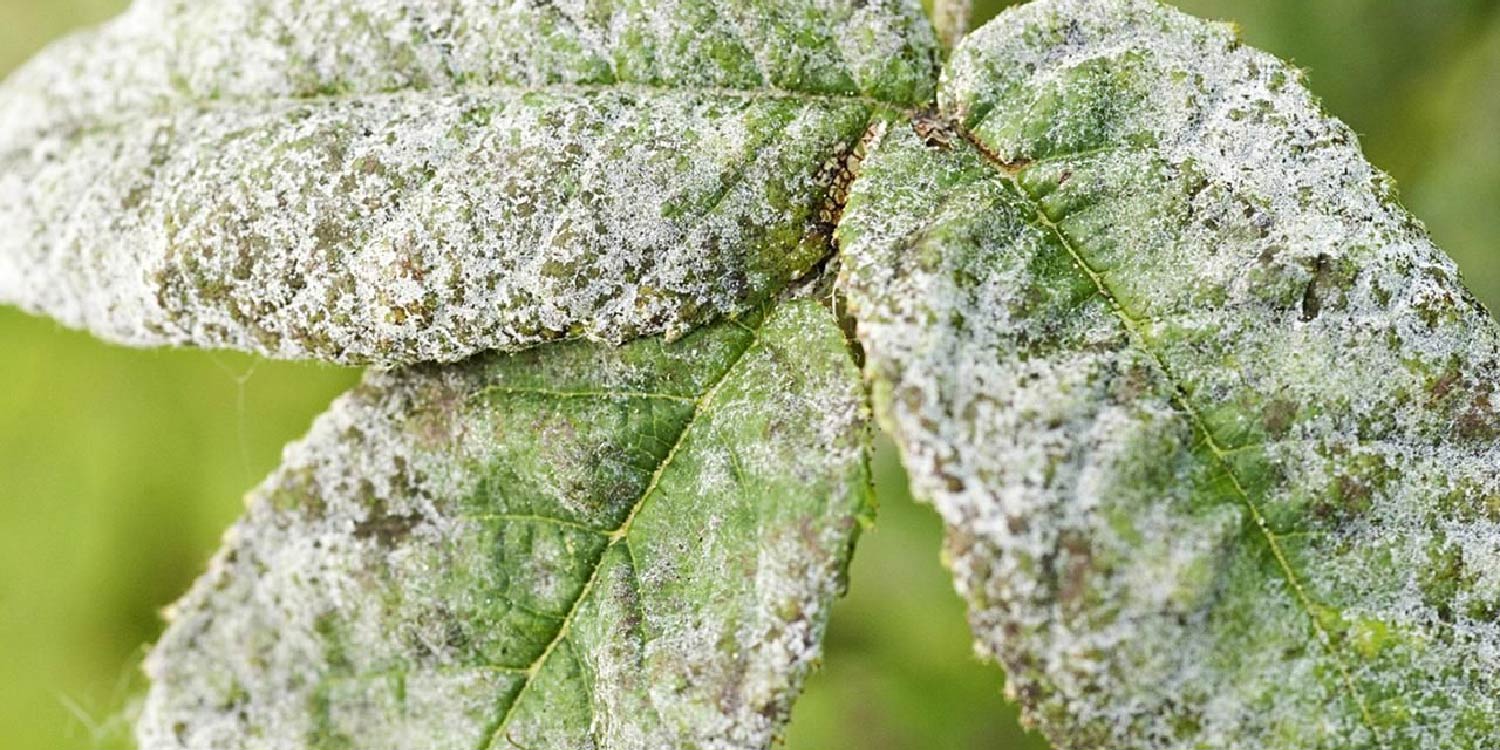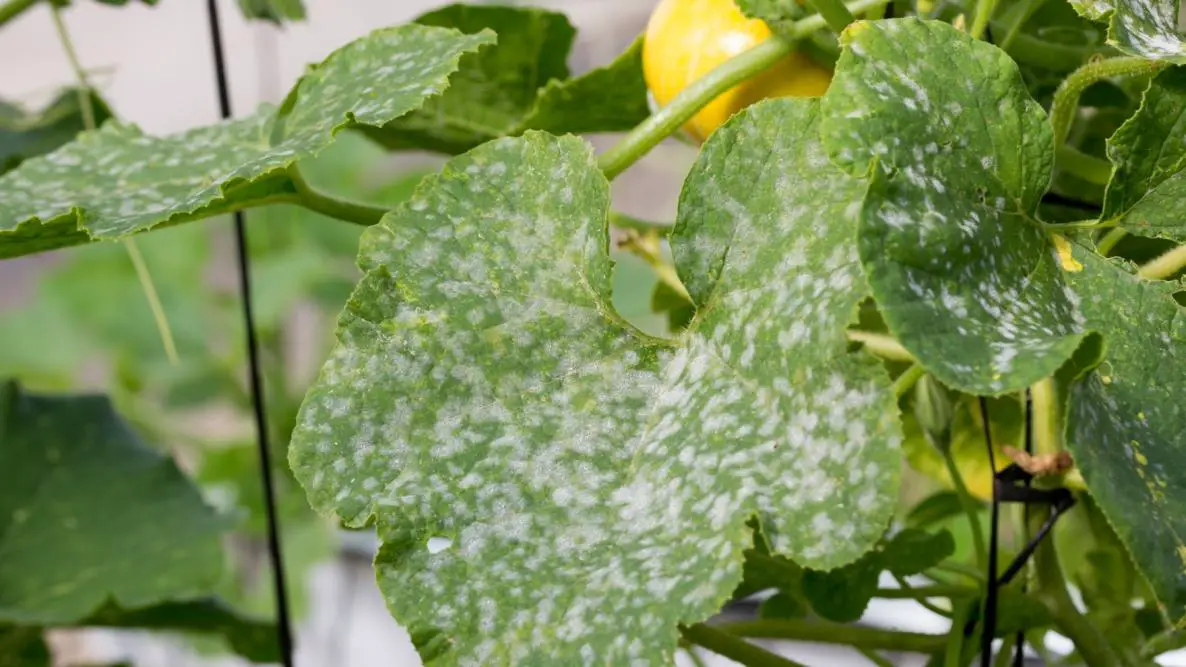Powdery mildew is one of the most prevalent diseases affecting ornamentals. It typically manifests itself with disfigured leaves and altered growth, yet rarely leads to plant death. There are various practices that can reduce or prevent this condition such as planting resistant varieties, providing adequate plant spacing to promote good air circulation, avoiding overhead watering practices, and removing infected leaves and stems that show symptoms.
Symptoms
Powdery mildew is one of the most prevalent diseases afflicting both herbaceous and woody plants in our landscapes, and its symptoms usually involve disfigured plant parts and poor health rather than serious damage or death. Different fungi produce this form of mildew disease, each attacking only specific types of plants.
Common symptoms of fungal growth on plant leaves, stems and occasionally flowers or young fruit include dusty white to grayish growth on leaves, stems and/or flowers, with occasional pepper-like spots forming as it advances. Its spores typically exist on the epidermis surface but can penetrate cells to release their own spores into cells within. Once inside cells, this fungus feeds on tissues to obtain nutrients and water by producing small tubular structures called “haustoria-like structures,” which penetrate its epidermis surface before eating tissue to obtain nutrients and water from within cells while producing tiny tubular structures called “haustoria-like structures”.
Fungal spores overwinter in clusters of infected shoots, buds, leaves and twigs or in plant debris on the ground. Fungus spreads via wind during warm and dry weather but less effectively during rainy or cool conditions; due to being plant specific it does not readily move from host to host although strains of it might become more or less severe on specific shade or flowering shrub types.
Fungus spreads to new leaves, stems and flowers through mycelia (thin white to grayish thread-like growths) produced by fungi. When they expand further, mycelia releases spores into the air that travel by wind currents until landing on succulent plant parts where infection can take hold. Young succulent growths are particularly vulnerable, although older leaves are also affected.
Infection thrives under conditions of high humidity, warm temperatures and indirect sunlight. Fungi thrive in environments with restricted airflow; such as large containers or gardens filled with plants where air circulation may be limited. Furthermore, mycelia can penetrate cell walls and produce spores within, helping cause infection to take hold quickly.
Detection
Powdery mildew spores often form mycelial mats on dormant buds or plant stems and leaves that remain dormant during dormancy, or on plant stems and fallen leaves that remain dormant during winter. When spring arrives with warmer and humid conditions, infected buds open and release their spores onto new host tissue – powdery mildew spores do not require free moisture in order to germinate, making them easily transportable by wind over long distances.
Powdery mildew affects mostly upper leaf surfaces, but this fungus can also infiltrate flower buds, young shoots and flowers. Heavily infected plants develop distorted growth and eventually wilt; photosynthesis decreases and food production is inhibited, leading to decreased yields and inferior fruits in infected plants.
Different strains of this fungus infect specific groups of plants; typically woody ornamentals like lilacs, flowering dogwood and azalea are most susceptible to its attack; however some cultivars of rose are also vulnerable. It also infests herbaceous plants like phlox, rudbeckias snapdragons and begonias.
Fungus are obligate biotrophs, meaning they depend on living host cells for sustenance and reproduction. Pathogens act like parasites by taking nutrients away from their hosts via parasitic haustoria in plant epidermal cells and transporting them back via mycelial networks in host epidermis cells to themselves via haustoria. Mycelia develops on its surface, which creates white-gray mycelium. Mycelium produces chains of conidia that disseminate with wind dissemi and become disseminate again by dispersion by wind currents.
Prevention of this disease involves many practices. Select resistant varieties when purchasing seed, and avoid planting crops known to be susceptible to the fungus. Prune away diseased tissue before gathering and disposing of dead foliage/plant debris as soon as it falls from trees/branches/trim. Limit overhead irrigation times so as to limit available moisture for germinating spores.
If you must grow crops that are prone to disease, employ preventive fungicide treatments early in the season. For vegetables this means treating when its first true leaves emerge while for cucumbers, squash and melons treating at first sign of powdery growth is crucial. When treating ornamental shrubs treat in midsummer to protect them from potential fruiting phase disease issues.

Prevention
Fungicides are often the go-to remedy when it comes to powdery mildew infestation, particularly preventative sprays that target specific spots on plants. Regular applications of preventative fungicide sprays help control and eliminate infections as soon as they emerge; but there are natural preventive and eradicant treatments as well. Vinegar contains acetic acid that kills powdery mildew yet is very gentle on plant life – just mix 2-3 tablespoons containing 5% acetic acid per gallon of water to quickly eliminate and control diseased spots!
Powdery mildew can be avoided by planting resistant varieties of vegetables, flowers and ornamental plants as well as trees and shrubs. Plants with higher resistance will produce fewer spores which won’t spread across other plants in your garden or greenhouse. It is important to remove and discard heavily infected plants immediately (even healthy parts can contain spores that will pollute other areas), since their spores survive over winter in leaf piles or plant debris before invading gardens and greenhouses come springtime.
Some fungi that cause powdery mildew form pepper-shaped resting structures known as cleistothecia that can be found in compost piles or on leaves and stems, providing inoculum for next season’s outbreak. Other strains overwinter as hyphae or fungal filaments in buds, fruits or other parts of living plants. Spors from these sources may then spread by wind or rain into new locations.
Preventive treatments should be administered as soon as a plant develops its first true leaves, and must be repeated on an ongoing basis throughout the growing season to protect it from mildew. Fungicides containing sulfur, copper or triadimefon have proven particularly successful against this scourge.
Other preventive measures include limiting overhead irrigation, allowing soil to dry before planting, and keeping plants open with less dense foliage for improved air circulation in the canopy. Fertilizing with organic compost and beneficial microbe mixes will further build up natural defenses of plants.
Treatment
Powdery mildew-causing fungus produces chains of conidia (spores) attached to conidiophores that disseminate through air currents and land on susceptible plant leaves, where they then germinate into thread-like projections that penetrate epidermal cells and penetrate plant tissues. These hyphae feed off nutrients absorbed from cells to cause spots on plants, leading to heavy infections that lead to leaf shrivel, browning and death. Furthermore, infected leaves may appear distorted or twisted while some species like Sedum or Kalanchoe may exhibit corky brown lesions. Infected cucurbits produce fruit that are susceptible to sunscald and don’t store well, along with symptoms including slow or stunted growth, an atypical scab-like lesion, witches’ broom and leaf curling. While this disease rarely kills plants completely, its presence diminishes gardens and landscapes significantly.
Powdery mildew is best treated by eliminating conditions in which its fungus thrives. This includes providing adequate air circulation by spacing plants appropriately and pruning for better air movement, along with adequate day/night watering that lowers humidity levels to avoid infection. Avoid high nitrogen fertilizer which stresses plants more readily to diseases like powdery mildew.
Powdery mildew strains vary by host-specificity, meaning if a barley field next to yours becomes infected it doesn’t necessarily indicate roses will succumb. Fungicides may help control powdery mildew disease but must be applied frequently and at high costs to be effective.
Some gardeners have discovered that applying a mixture of baking soda and liquid soap as soon as symptoms appear can help combat mildew. Combine 1 tablespoon of baking soda with 1/2 teaspoon of liquid soap such as Castile soap in one gallon of water and spray onto all leaves and stems of plants that show symptoms; repeat as needed to treat existing mildew growth.
Copper fungicides offer another solution for controlling disease in organic settings. These less costly alternatives to sulfur fungicides often come in ready-to-use formulations that connect directly to your hose, and have been listed by the Organic Materials Review Institute as safe for organic use.

